Zero-waste gardening is becoming increasingly important in the effort to reduce our carbon footprint and promote sustainable living. What is a zero-waste garden? The idea behind the zero-waste gardening tips I am sharing is to minimize the amount of waste produced during the gardening process.
This includes the use of composting, recycling, and upcycling, as well as avoiding the use of harmful chemicals and pesticides. By reducing waste and harmful environmental impact, zero-waste gardening promotes a healthier ecosystem and helps to combat climate change.
Eco-friendly gardening can have a positive impact on our health. By avoiding the use of harmful chemicals and pesticides, we can reduce our exposure to toxins and potentially harmful substances.
Additionally, growing our own produce can lead to a healthier diet, as we have more control over the quality and freshness of the food we consume. This can also help to reduce our reliance on processed foods and packaging, further reducing waste.
Zero-waste gardening can also be a cost-effective and fulfilling way to grow our own food. By using compost and natural fertilizers, we can reduce the need for expensive chemical fertilizers and pesticides.
Upcycling materials and using recycled containers can also help to reduce costs associated with purchasing new gardening supplies.
Overall, this zero-waste gardening provides a sustainable and environmentally friendly way to grow our own food, while also promoting a healthier and more fulfilling lifestyle.
Posts feature partner companies & may be sponsored. Post contains affiliate links & I will be compensated if you make a purchase after clicking on links. As an Amazon Associate I earn from qualifying purchases.
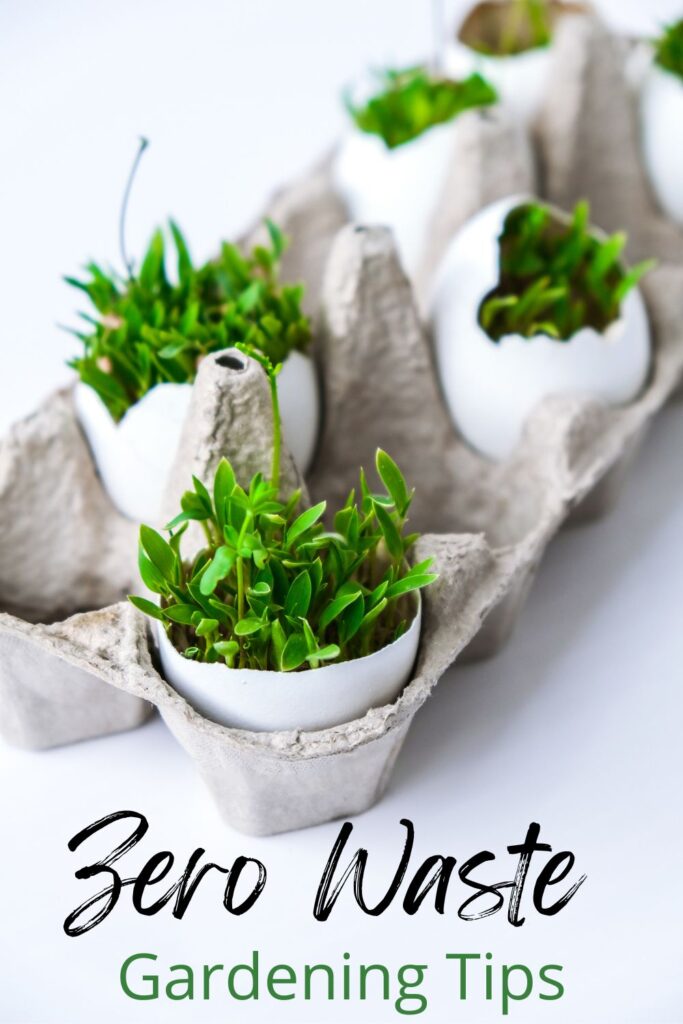
Table of Contents
How to start zero-waste gardening like a pro
If you would like to start a more eco-friendly garden, follow a few of these zero-waste gardening tips to get started on your journey of growing more food with less waste.
Avoid plastic bags of topsoil and potting soil
Growing a zero-waste garden is an important way to reduce the environmental damage caused by plastic. One of the most impactful steps you can take towards creating a more eco-friendly garden is avoiding plastic bags of topsoil and potting soil.
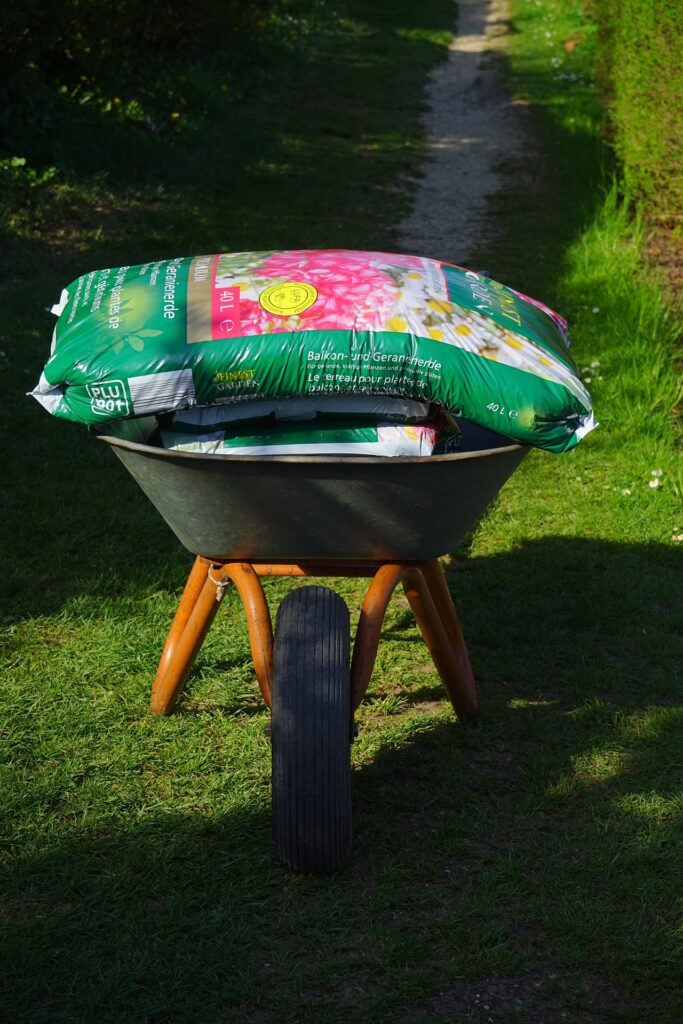
✯Don’t want to miss the next post?✯
Follow Turning the Clock Back on Facebook | Twitter | Pinterest
Or join the private Facebook group for simple tips on going green!
These bags are made from petroleum products and are not biodegradable, resulting in long-term environmental pollution. Additionally, many soils have been over-processed for commercial use, stripping them of their essential nutrients and making them unable to support healthy plants.
By buying natural unpackaged soils, or finding package-free alternatives, you can ensure that your garden has the necessary organic matter to grow strong and healthy plants without harming the environment.
Build hugelkultur beds for plastic-free gardening soil
Hugelkultur beds are an excellent way to create a zero-waste garden without using any plastic or soil. By building these raised beds, you can make use of fallen tree branches, logs, and other woody debris that would otherwise be discarded as waste.
The large amount of organic matter in these beds helps to retain moisture and provide essential nutrients for your plants. Additionally, you can use woodchips and other materials to create a mulch layer around the beds, further helping to retain moisture and reduce the amount of water needed for your plants.
5 steps to building Hugelkultur beds:
- Choose the location for your bed
- Dig a trench, about 2 feet deep and 6-8 feet long depending on the size of your bed
- Place branches in the bottom of the trench and then fill it with woodchips, leaves, and other organic matter
- Add soil on top of the organic layer and then plant your desired plants
- Lastly, cover the bed with a layer of mulch to help retain moisture
Reach out to local nurseries for soil delivery
If you don’t have access to natural soil, you can also reach out to local nurseries to see if they offer delivery. Many nurseries now provide delivery services for bulk soil purchases, which can be beneficial for sustainable gardening.
This is especially beneficial because some nurseries use organic and sustainable practices when producing their soil, meaning that your garden will be getting the best soil available. Additionally, these nurseries can often provide helpful advice on how to create a zero-waste garden and care for your plants.
Practice crop rotation regularly to maintain soil fertility
Crop rotation is an essential part of low-waste gardening. By rotating your crops every season, you can help to maintain soil fertility and reduce the need for chemical fertilizers.
Additionally, crop rotation can help to prevent pests and diseases from taking hold in your garden by disrupting their life cycles. This practice helps to create a healthier environment.
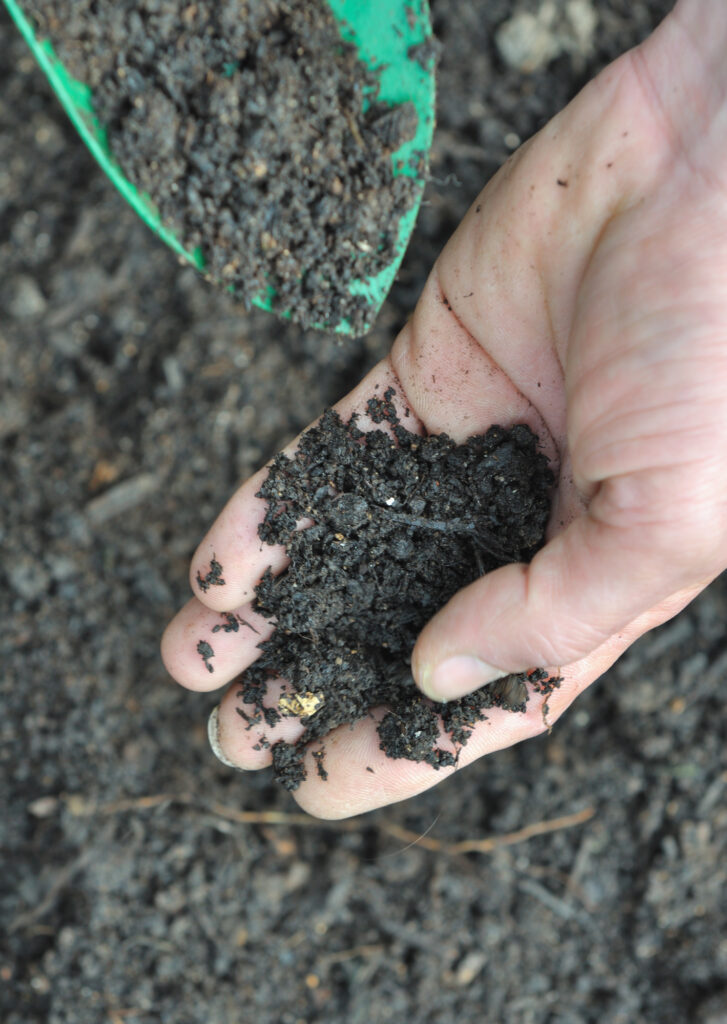
Look for low-waste fertilizers
Chemical fertilizers can be a hazard to an eco-friendly garden, as they often come in plastic bottles and contain harsh chemicals that can pollute the soil and water around them. The ingredients found in traditional chemical fertilizers, such as nitrogen, potassium, and phosphorous, can leach out into the soil and water table if not applied correctly.
Additionally, these products are often manufactured with petroleum-based packaging that cannot be recycled or composted. This means that using chemical fertilizers can lead to increased trash creation.
To create an eco-friendly garden, it is important to only use an organic fertilizer that does not contain any harsh chemicals or comes in plastic packaging.
Use gardening by-products
Compost tea is a great plastic-free fertilizer. To make it, simply mix compost from your compost bin and water together and steep for a few hours. For ease of use and cleaning you can use a compost tea filter bag. This mixture can be used to fertilize your garden without the need for any plastic packaging or harsh chemicals.
Compost food scraps, avoid buying plastic bags of black gold
Food waste is a huge concern in our country. You can use kitchen scraps, such as vegetable peels and eggshells, to create homemade fertilizer. By adding food scraps to your compost pile, you can help to create nutrient-rich soil without the need for any plastic packaging. It’s also a great way to reduce food waste at home. Check out my post about what to do with food scraps at home for more ways to reduce food waste.
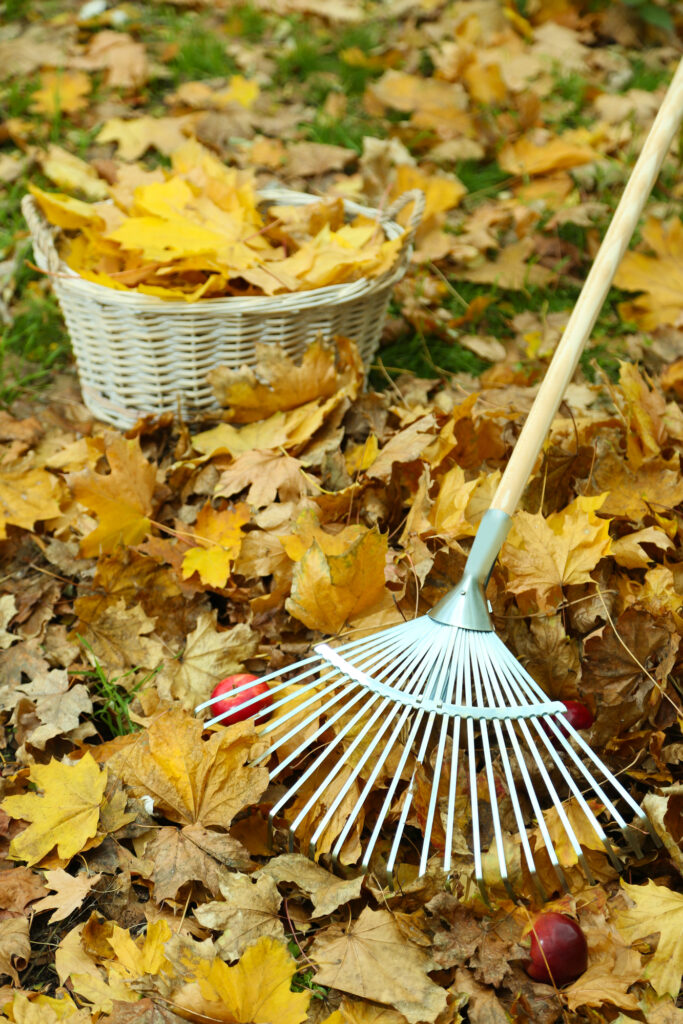
Use plastic-free mulch in your garden
There are several options to choose from for plastic-free mulch. For example, you can use wood chips, straw, wet newspapers, or leaves to create a mulch layer around the beds. This helps to retain moisture and reduce the amount of water needed for your plants.
You can also contact your local tree service and ask them to deliver a large pile of woodchips to your house. We put our kids to work for many years spreading mulch in our yard to control weeds in our landscaping.
Further Reading: How to use cardboard as weed control.
Starting the Plants
Once you have decided what plants you want to grow, you need to start growing them. From free seeds to alternatives to plastic trays, here are a few zero-waste gardening tips to get you started.
Use eggshells, egg cartons, or newspaper for seed starting
Plant seeds and cuttings in paper and cardboard. Eggshells, egg cartons, and newspapers make great biodegradable pots for seed starting.
Starting seeds in eggshells, egg cartons, and newspaper pots is an easy and eco-friendly way to begin your garden. Eggshells can be used as mini planters when filled with soil. Simply fill the eggshells with a fertile soil mix, plant the seeds of your choice, and water as needed. When the seeds sprout, you can plant the entire eggshell ‘container’ in your garden.
Egg cartons work similarly, but are larger and can accommodate multiple plants at once. Newspaper pots are also a great option for starting seeds, as they can be made from recycled newspapers and require no additional materials.
To make them, the easiest way is to buy a newspaper seed pot maker. Fill them with seed-starting soil and plant your seeds. Then, place it in a sunny area to germinate. Read my post about seed-starting tips before you begin.
Collect seeds from plants you already have growing in your garden
Many types of plants are self-seeding, meaning they will produce seeds that can be collected and planted in the spring. Collecting your own seeds is a great way to add variety to your garden without having to purchase any seed packets.
You can also save money by collecting and reusing seeds from fruits and vegetables. Simply let the fruits and vegetables dry out until the seeds can be easily removed, then store them in a paper envelope or glass jar until you are ready to plant in the spring. You can get paper seed envelopes and write all the information on them that you will need to know next year for planting.
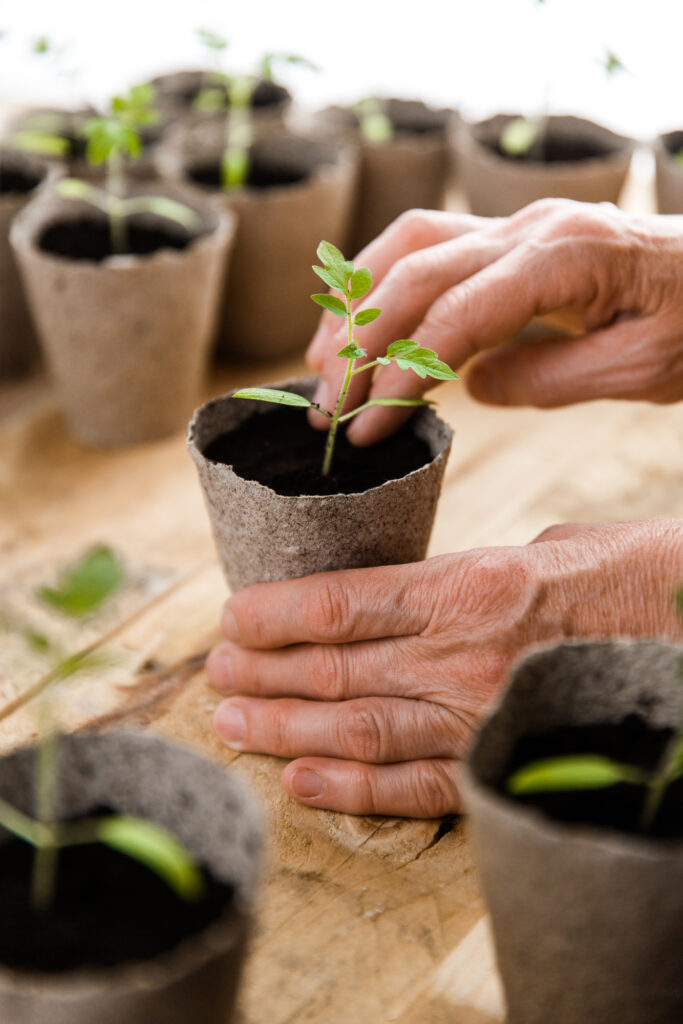
Grow plants from cuttings to skip the plastic pots
You can also skip the plastic pots by propagating plants from cuttings. This involves taking a cutting or stem of an existing plant, allowing it to root in water, and then planting it in soil.
Some vegetables can grow from cuttings, but it’s important to note that not all vegetable plants are suitable for this propagation method. Here are a few examples of vegetable plants that can be propagated from cuttings:
Tomatoes: Tomatoes can be propagated from stem cuttings. Simply take a cutting from a healthy tomato plant and remove the lower leaves. Plant the cutting in moist soil and keep it in a warm, sunny spot. Roots will begin to grow, and you can transplant the new tomato plant once it has been established.
Peppers: Peppers can also be propagated from stem cuttings. Take a cutting from a healthy pepper plant and remove the lower leaves. Plant the cutting in moist soil and keep it in a warm, sunny spot. Once the roots have been established, you can transplant the new pepper plant.
Sweet potatoes: Sweet potato vines can be propagated from stem cuttings. Simply take a cutting from a sweet potato vine and place it in a jar of water. Once roots have formed, you can transplant the new sweet potato vine into the soil.
Basil: Basil can be propagated from stem cuttings as well. Take a cutting from a healthy basil plant and remove the lower leaves. Place the cutting in a jar of water and keep it in a warm, sunny spot. Once the roots have been established, you can transplant the new basil plant into the soil. Basil likes warm temperatures so don’t transplant it when the weather is cold.
Remember to keep the soil moist and provide adequate light and warmth for the new plants to grow successfully. If you don’t have a lot of indoor lighting, buy some indoor grow lights to help your seedlings grow.
Ask local gardeners
Local gardeners are a great source of support. If you have questions about getting your garden beds to thrive, head to your local farmers market and ask a gardener. Also ask if there is a nearby community garden, which is a great source of plants and other garden resources.
Check for free plants in the compost bin
Have you ever heard of a volunteer plant? These are plants that have naturally sprouted from seeds in your compost bin. You can harvest these free plants and give them a new home in your garden.
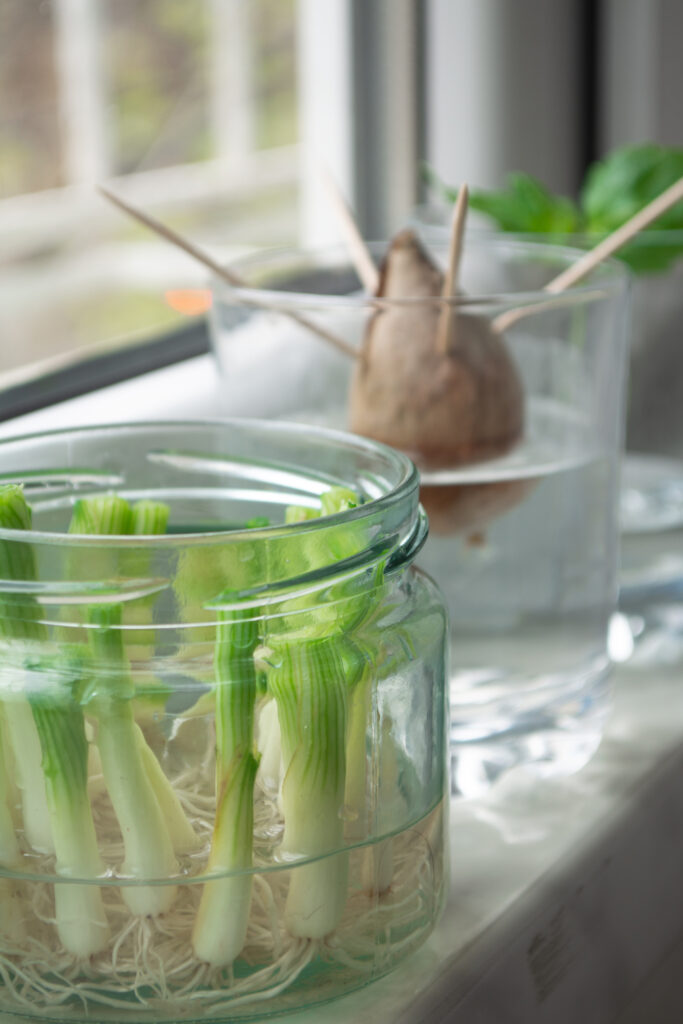
Grow food from scraps
There are many types of food that can be grown from scraps, such as potatoes, onions, and celery. Simply take the parts of the vegetable you would normally throw away (such as potato eyes or onion roots) and plant them in the soil. With a little care and attention, they will soon sprout new plants or new edible greenery. Here is a short list of plants that grow well from food scraps:
- Celery
- Green onions
- Carrot (the tops will regrow, which you can use in my carrot top pesto)
- Sweet potato
- Beets (beet greens are edible, you cannot regrow the root itself)
- Radish (same as above, radish greens are edible)
- Garlic (check out my post about how to grow garlic)
- Potatoes
- Lettuce
Rehome plastic pots
When gardening with plastic pots, it’s important to remember to reuse or recycle them whenever possible. Plant pots can be easily reused for new plants, or recycled through a local recycling center.
If you can’t reuse them yourself, ask other local gardeners if they need them. You can post your offering on Freecycle or your local buy-nothing group.
Plant native species that require less maintenance
Native plants will thrive with little work from you, which means less waste is created as they grow. Look for native fruit trees and flowers that bloom throughout the growing season to help attract pollinators. All they will usually need is some garden compost to really thrive.
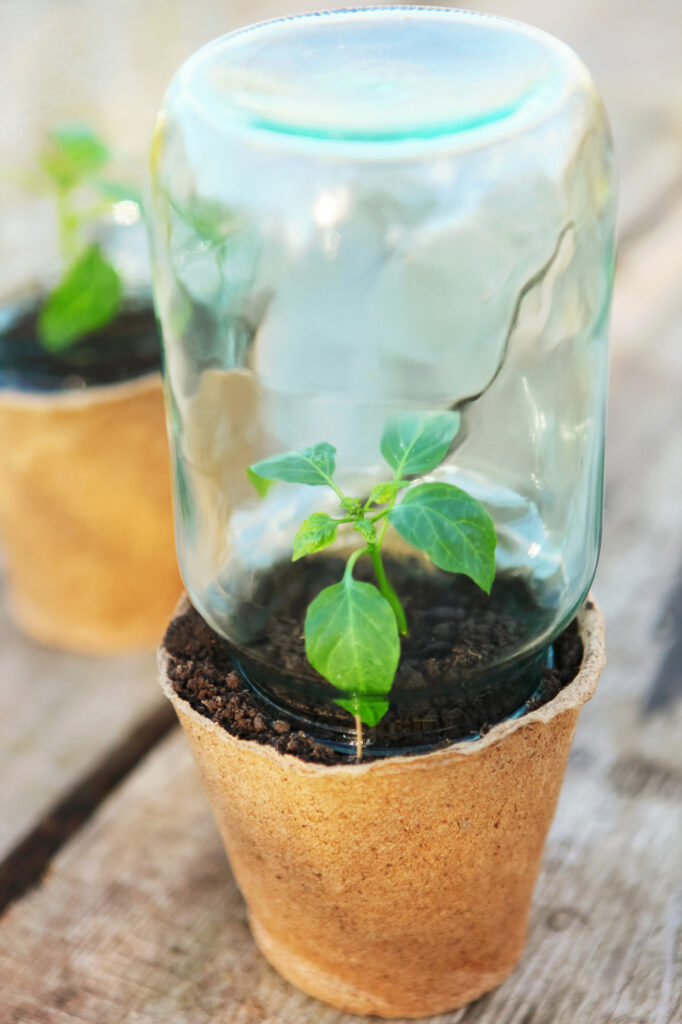
Protect young plants with glass jars, not plastic row covers
Plastic row covers are often used to protect young plants from pests, but this creates a lot of plastic waste. Instead, use glass jars or containers to cover your plants until they mature and become more resilient.
Choose natural weed control methods
Pesky weeds are the bane of my existence when it comes to gardening. If left unchecked, your once thriving garden will become an unmanageable mess. Whether you mulch with grass clippings or newspaper, you don’t have to create waste to control weeds. Read my post about how to use a flame weeder if you are feeling adventurous!
Leave the leaves
We often rake and bag up leaves in the fall, but these can be an excellent source of nutrient-rich compost for your garden. Instead of hauling them away, use them to build a compost pile or spread them around plants as mulch.
Look for free mulch
Community centers, parks, and even some local farms often have free mulch available for gardeners. Search online or call ahead to find out where you can get some for yourself.
Reduce Your Water Consumption
If you are looking for gardening tips that save you money, this is it. Reducing outdoor water usage helps you stop wasting water and cut back on your bills at the same time.
Time it right
The best time to water your garden is in the morning when there is less evaporation, and the soil will absorb more of the water. Try to water your garden just two or three times a week, rather than every day.
Water barrels
Rain barrels help save rain so you can use less of the water from your well or local utility company. A lush garden requires regular watering so set up a rain barrel to stop wasting water.
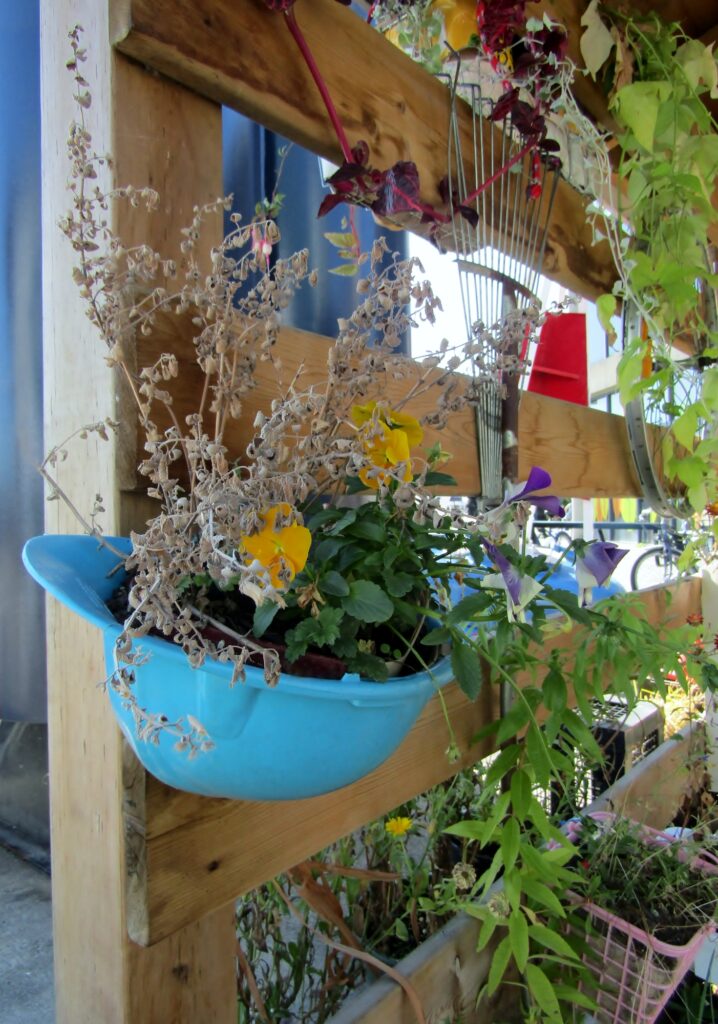
Don’t waste space
Incorporate vertical gardening practices by using trellises, hanging baskets, or wall-mounted planters. Have a designated area where weeds can be cut down and left undisturbed to return nutrients back to the soil. Check out these vertical gardening ideas for inspiration.
Gardening Tips for Pest Control
Keeping pests at bay in your garden is challenging, however, you will see a huge difference by utilizing a few of these zero-waste pest control tips:
Strong plants resist disease better
Healthy plants are more resistant to pests and disease so start by adding your own compost to the garden when the plants are small. Keep them well-pruned and healthy so they will resist disease.
Pluck by hand
One of the quickest, easiest, and most sustainable solutions for controlling pests is to manually remove them. Use gloves to pluck the bugs from your plants and put them in a bucket of soapy water.
Natural Pest Control
Choose pest control methods that are non-toxic and effective, such as companion planting and natural predators (e.g ladybugs). Check out Companion Planting for Beginners to get started.
Try companion planting
Companion planting is an ancient gardening technique that uses various plants to ward off pests. Planting certain combinations of vegetables, herbs, and flowers together can help keep your garden healthy without having to resort to chemical pesticides or fertilizers.
Don’t let your harvest go to waste
Harvest from your garden when plants are at their peak. If you cannot use all of the produce, consider sharing it with family, and friends or donating to a food bank.
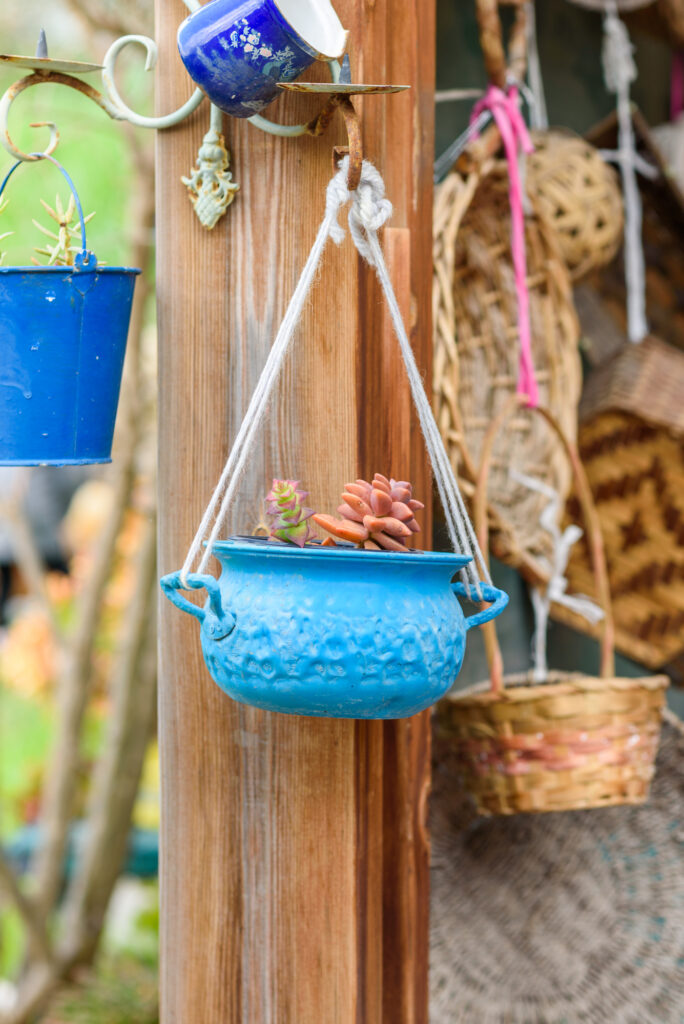
Upcycle and Recycle what you can
Use old newspapers, magazines, or cardboard to create compost instead of throwing them away. Reuse containers such as egg cartons or yogurt cups to start new seeds. You can even make your own plant markers out of twigs and stones to help you keep track of what’s growing in your garden.
Get creative
Make use of recycled materials such as glass jars, stones, or bricks when creating planters or raised beds. Reuse materials that would otherwise end up in the landfill to make garden furniture, decorations, and compost bins.
Make eco-friendly garden markers
Check out these upcycled garden marker spoons if you want to get crafty this spring.
Make friends with other gardeners
Connect with other gardeners in your area who can share advice, tips, and seeds. You may also be able to get access to compost or soil they no longer need.
Borrow gardening tools from fellow gardeners
Don’t buy new tools if you don’t have to. Borrow from your friends or neighbors and make sure to return them when you are finished.
Join a local community garden
Community gardens are a great way to get involved in urban gardening and meet other gardeners. You can share tips, and resources, and learn more about zero-waste gardening practices.
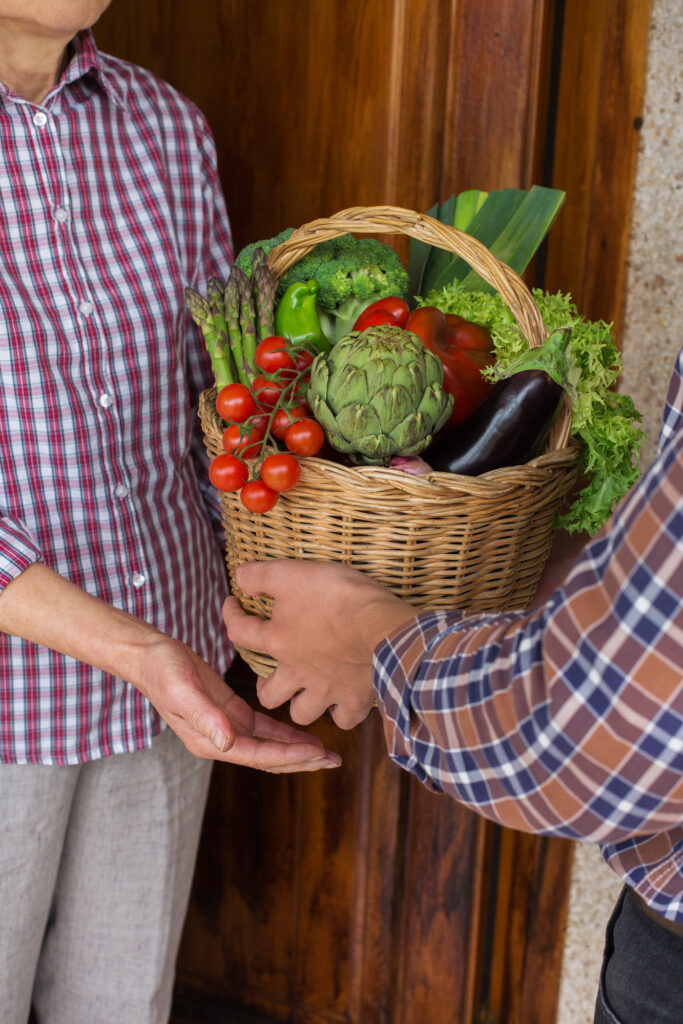
Final Thoughts
Gardening is a great way to feed a family, live more sustainably, and enjoy healthy food. However, it can also be costly and create a lot of waste if you let it.
A compost heap and some hand-me-down terracotta pots that you find at a garage sale are all you need to get started.
If you want a few more gardening tips, check out a few of these posts:
- Tips for Comfortable Gardening: Don’t let a sore back and bad knees keep you from enjoying a backyard garden!
- Foodscaping Ideas: You can grow food, even if you don’t have room for a traditional garden bed.
- Essential Gardening Supplies: Make sure you have a few of these things on hand before you get started.
If you have any other zero-waste gardening tips to share, I would love to hear from you. Leave a comment and let me know what you are doing to take your zero-waste lifestyle out into the garden!
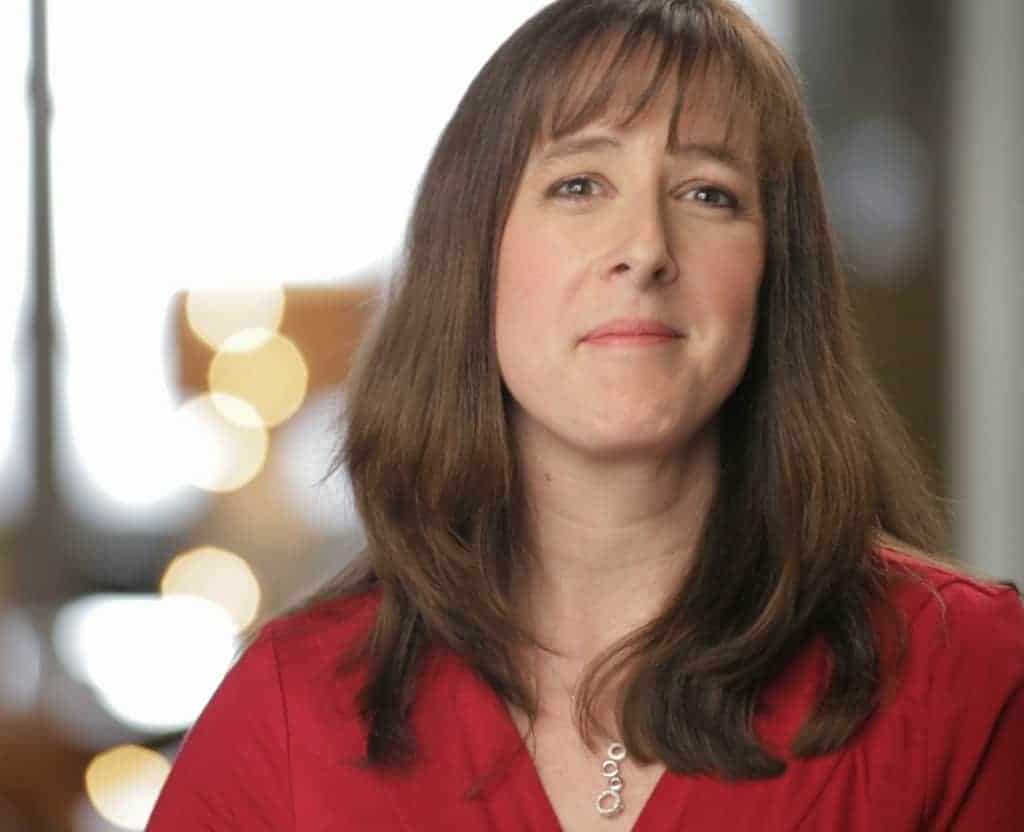
Diane is a professional blogger and nationally certified pharmacy technician at Good Pill Pharmacy. She earned her BS in Microbiology at the University of New Hampshire and has worked in cancer research, academics, and biotechnology. Concern over the growing incidence of human disease and the birth of her children led her to begin living a more natural life. She quickly realized that the information she was learning along the way could be beneficial to many others and started blogging and freelance writing to share this knowledge with others. Learn more about her HERE.

In the last couple of years I’ve definitely been learning how to re-use my soil by enriching it with compost and other materials and it’s been a great experience, not to mention money saving. Now to look into bulk soil delivery.
Sustainable gardening is the way forward, and zero-waste practices are essential. Learning to reuse, recycle, and minimize waste is crucial for a greener tomorrow, thanks for sharing!